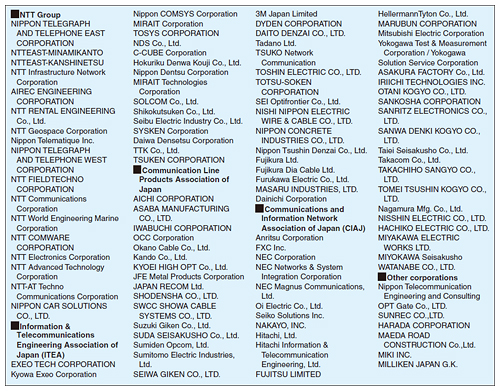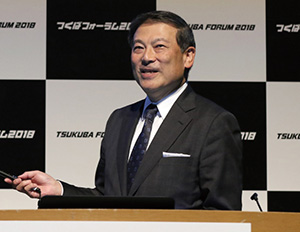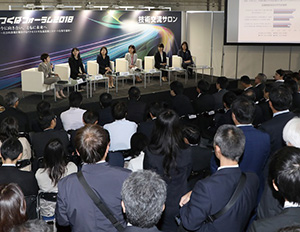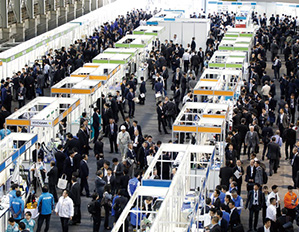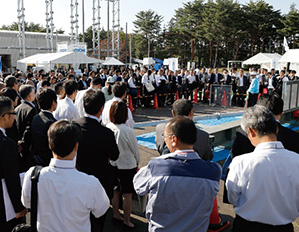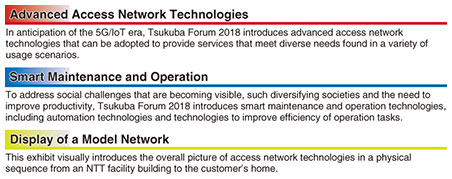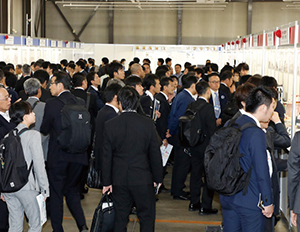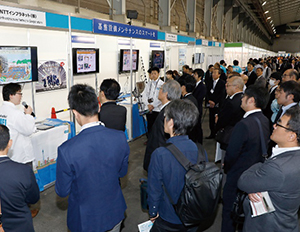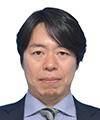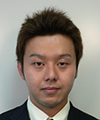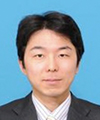 |
|||
|
|
|||
|
Information Vol. 17, No. 4, pp. 36–44, Apr. 2019. https://doi.org/10.53829/ntr201904in1 Event Report: Tsukuba Forum 2018AbstractTsukuba Forum 2018 was held October 25 and 26. The theme of the forum was “Enhancing social well-being, moving forward together—Address social challenges with advanced access network technologies and smart maintenance and operation.” This article gives a brief overview of the speeches and exhibits presented at the forum. Keywords: Tsukuba Forum, access networks, maintenance and operation 1. IntroductionThe Tsukuba Forum is Japan’s largest integrated symposium on technologies related to access networks. The main theme of the 2018 event was “Enhancing social well-being, moving forward together—Address social challenges with advanced access network technologies and smart maintenance and operation.” It was held with the intentions of moving forward together with customers as Your Value Partner by earnestly developing technologies that address a variety of social challenges. In addition to NTT Access Network Service Systems Laboratories (AS Labs), 108 organizations, including co-hosting institutions and NTT Group companies (Table 1), participated. They introduced and exhibited the latest research and development (R&D) and technological trends.
2. Overview of speechesThe keynote speech and a special speech were given at the Tsukuba International Congress Center on the first day. They were relayed from the main convention hall of the International Congress Center to a venue at the NTT Tsukuba R&D Center. The speeches were received by a large audience. 2.1 Keynote speechMr. Hiroshi Tanabe, Executive Vice President of NTT EAST, gave a speech entitled “NTT EAST Business Trends and Activities for Network” (Photo 1).
First, Mr. Tanabe introduced NTT EAST’s management trends as indicated by changes in operating revenue and operating income. He showed that in the last several years, NTT EAST continued to attain record profits and gave two major reasons for this. First, the earnings structure is steadily changing. Although income has come mainly from metal cable-based voice communication, it is shifting to income from optical fiber-based IP (Internet protocol) communication. Another reason is that NTT EAST has been able to continually improve operational efficiency by reducing expenses to a greater extent than the growth in revenue. In this way, the company has been able to secure profits. Concerning revenue and income trends, Mr. Tanabe described in detail efforts to expand optical fiber services. The number of subscribers of FLET’S HIKARI has increased steadily since the service began. Mr. Tanabe stated that in addition to product capabilities such as cables, optical cords, and splitters developed by the NTT research laboratories, sales capabilities, including those of sales agents, have built a system in which customers can use FLET’S HIKARI with peace of mind. In addition, NTT EAST has improved productivity by introducing technologies such as fused optical core fibers, which has led to a decrease in the number of repair dispatches for failures per month year after year, and by visualizing the volume of work, such as onsite repair operations and line maintenance tasks. On the other hand, because productivity improvement efforts are reaching their limits, Mr. Tanabe emphasized that NTT EAST is moving into an era in which productivity must be improved in a nonlinear and qualitative manner. He introduced three pillars of NTT EAST’s efforts for efficient facility operations—smart onsite work, smart online support, and smart work methods—with specific examples. As an example of smart onsite work, Mr. Tanabe described a new diagnostic technology that measures bending in utility poles by using a mobile mapping system (MMS). With the MMS, high-precision three-dimensional maps can be created by taking spatial measurements of facilities in an environment with a traveling car equipped with laser scanners, cameras, and GPS (Global Positioning System). As a result, The MMS makes it possible to inspect up to 200 poles in one day, in contrast to the maximum of 7 poles per day using commercial off-the-shelf measuring equipment. Mr. Tanabe emphasized that such an automated inspection system was found nowhere else in the world. For smart online support, Mr. Tanabe gave the example of integrating internal and external office work. For example, a wide range of onsite work can be done by one worker by providing remote support via video and giving guidance to the onsite worker. Mr. Tanabe stated that NTT EAST’s strength will be in having workers who are capable of dealing with all onsite situations. Furthermore, for smart working methods, Mr. Tanabe introduced the example of the variable working hour system in which workers in Hokkaido work different hours during summer and winter. He also presented a project by women employees—who have been increasing in number in recent years—to improve the onsite work environment, and activities to visualize and improve safety by reviewing one’s actions through the introduction of stationary cameras in onsite environments. In addition, Mr. Tanabe described NTT EAST’s efforts to create disaster-resilient facilities. As efforts in the aftermath of the Great East Japan Earthquake in 2011, he introduced a wide range of countermeasures being undertaken by NTT EAST. These include measures to prevent electrical outages, such as installing emergency engine generators and backup batteries, and protective measures in the event of a tsunami, involving moving communication buildings to higher elevations. Finally, Mr. Tanabe concluded his speech with powerful words. He stated that to support the success of various events to be held in Japan by 2020, NTT EAST is taking on the mission of steadfastly protecting the communications infrastructure. His speech was valuable for introducing a variety of specific efforts by NTT EAST. 2.2 Special speechMr. Hiromasa Takaoka, Senior Vice President of NTT Communications, gave a speech entitled “Digital Transformation of NTT Communications” (Photo 2).
First, Mr. Takaoka gave an outline of NTT Communications’ Vision 2020. Vision 2020 represents NTT Communications’ goal to become a global information and communication technology (ICT) provider recognized around the world through advanced services. The slogan of Vision 2020 is “Transform. Transcend.” It means that NTT Communications’ services and technologies will dramatically evolve and dynamically transform businesses, markets, and society (Transform), and create new value that exceeds expectations. By transcending the boundaries that limit people, they will realize a seamlessly connected world (Transcend). Mr. Takaoka stated that furthermore, NTT Communications is seeking to improve all processes by leveraging its knowledge and technologies accumulated to date in order to go to market as quickly as possible with advanced technologies and services. Among these efforts, digital transformation (DX) is a pillar to achieve Vision 2020. Mr. Takaoka said that it is a major push by NTT Communications to continue to provide new value by supporting customers as a DX EnablerTM. Mr. Takaoka then introduced NTT Communications’ effort to build its Data Distribution Platform to realize Vision 2020. To realize an environment that can richly provide flexible and highly reliable services to customers according to their needs with the Data Distribution Platform, NTT Communications is working to connect globally deployed datacenters; to develop and utilize software-defined networking technologies and multi-orchestrator, which optimally combine a variety of software functions; and furthermore, to implement thorough security management. Diverse functions such as order management, customer management, and billing and settlement are necessary in order to achieve these extensive service line-ups. Mr. Takaoka stated that, as a result, it is necessary to collaborate with partner companies and develop useful functions. He said that such cooperation will be possible by precisely defining, adjusting, and releasing application programming interfaces (APIs), an effort to which NTT Communications is presently devoting its energy. In addition, for security measures, as information distribution is becoming globalized, new demands are growing for personal information protection at national and regional levels. Responding to these needs is becoming more urgent. Besides datacenters, NTT Communications possesses network infrastructure. This makes it possible to visualize data storage locations and communication routes, making it possible for NTT Communications to provide strengthened security measures to customers. Next, Mr. Takaoka introduced specific examples of DX. First, he presented an effort to automatically respond to customers’ inquiries and issues. This system utilizes artificial intelligence (AI) technologies and big data analysis to provide automated handling, from responding to customers’ voice inquiries to diagnosing problems. Mr. Takaoka also stated that for the challenge of developing automated maintenance operations, NTT Communications has developed an automated system that orchestrates a series of work processes, from detection of network failures and repair to notification of customers. Using this system, the company was greatly able to improve the speed of responses compared with the previous system. Going forward, NTT Communications will leverage the technologies of this system, expand the range of automation with DX, and actively propose these DX technologies to corporate customers. 3. WorkshopsOn the second day of Tsukuba Forum 2018, workshops were held at AS Labs. An Executive Research Engineer from NTT DOCOMO and two Project Managers from AS Labs conducted the workshops (Photo 3).
3.1 Workshop 1Mr. Yukihiko Okumura, the Group Leader of NTT DOCOMO 5G Laboratories’ 5G Radio Access Network Research Group, gave a lecture entitled “Co-Creation of New Services and Resolution of Social Problems by Utilizing 5G.” First, he presented the latest status of NTT DOCOMO’s efforts to launch fifth-generation mobile communication networks (5G) services. Mobile communication speed has increased 400,000 times over the past 25 years to reach 988 Mbit/s. Mr. Okumura stated that the performance target of next-generation 5G is 20 Gbit/s, and furthermore, with the advent of 5G and the creation of new value, mobile traffic is expected to dramatically increase. NTT DOCOMO is seeking to begin commercial 5G services in the spring of 2020. With its mobile network as the core, the company seeks to create new value and address social challenges with DX as the pillar, combining AI, augmented reality (AR)/virtual reality, and the Internet of Things (IoT). 5G will also have the three features of high-speed/high-capacity, low latency, and connections with numerous terminals. Moreover, 5G services are being expanded from urban to rural areas with appropriate functions and radio frequencies. Mr. Okumura explained that NTT DOCOMO will create new value by co-creating services and technologies with a wide range of partners. Next, he discussed five examples of 5G applications that utilize high-speed communication, low latency, and high-resolution video to tackle a variety of social challenges: (1) remote operation of construction equipment to deal with the issue of a shortage of manpower in the construction industry, (2) remote operations using humanoid robots to confirm safety and restore services quickly after a disaster, (3) remote healthcare using high-resolution diagnostic imaging to reduce the disparity in medical care between urban and rural areas, (4) check-ups of expectant mothers using next-generation mobile medical clinic vans, and (5) surveillance of facilities with high-resolution video to ensure safety and security. 3.2 Workshop 2Mr. Takeshi Arai, Project Manager of AS Labs’ Access Network Management Project, gave a lecture entitled “Research and Development of New Operation Techniques for Access Network Infrastructure.” First, Mr. Arai explained the background situation of network access facility operations. He stated that Japan’s population of people in their productive years is declining, and that NTT facilities maintenance personnel responsible for access network operations are also aging. It is thus necessary to consider construction methods that prevent network access problems from occurring in the first place, even with lesser availability of workers’ skills. He stated that NTT is seeking to eliminate inspections, which consume the most work during operations. As steps to reach this goal, he presented three steps in NTT’s research to reduce inspections to zero: (1) practical application of MMS-based automatic utility pole diagnostic technology, (2) efforts to automatically inspect cables, guy wires, and suspension wires, in addition to utility poles, and (3), in the future, the use of AI to predict deterioration in facilities. Mr. Arai explained that creating added value from the multi-stratification of various kinds of data makes it possible to reduce operations efficiently. Next, Mr. Arai introduced applications of sensing technologies. He discussed NTT’s MAC (media access control) address capture technology for measuring networks beyond splitters and vibration sensing technology for identifying flooded manholes. He also presented safe work methods such as a method for safe road-crossing construction and the use of AR-based pre-work inspection. Concerning the direction of access network facility operations going forward, Mr. Arai stated that NTT seeks to eliminate inspections and reduce onsite observer work by establishing new inspection standards obtained by integrating multiple kinds of data, with the goal of minimal operations. 3.3 Workshop 3Mr. Jun Terada, Project Manager of AS Labs’ Optical Access Systems Project, gave a lecture entitled “Perspective on Optical Access Network.” First, Mr. Terada stated that in regard to conditions for optical access, it is necessary to consider how to stably and continuously use and maintain the great number of facilities and deal with diverse uses of optical access in the 5G/IoT era. With this need in mind, he explained that high flexibility and low maintenance are key terms for optical access networks needed in the future. To achieve such a network, technologies to modularize and virtualize access functions are critical. Transport functions and service functions must be segregated, and the sharing of the optical network access by overlapping services is key. Next, Mr. Terada presented FASA®* (Flexible Access System Architecture), AS Labs’ concept to realize these goals. FASA enables modularization of functions, establishment of common APIs, softwarization of functional blocks, and cloud operations. Furthermore, Mr. Terada introduced mobile base station accommodation passive optical network (PON) and virtual optical line terminal (OLT) as applications of FASA. This PON realizes low latency with corporative dynamic bandwidth assignment (DBA) implemented with FASA’s technology. Virtual OLT is an SFP (small form-factor pluggable) OLT; it provides easy optical access service to areas where optical access is not yet available. Mr. Terada also discussed AS Labs’ participation in international standardization activities, such as FSAN (Full Service Access Network), ITU-T (International Telecommunication Union - Telecommunication Standardization Sector), and BBF (Broadband Forum), and open development efforts at ONF (Open Networking Foundation).
4. Planned eventsIn addition to the speeches and workshops, various events were held that were well received by the visitors. 4.1 Panel discussionFor the first time at Tsukuba Forum, co-hosting organizations, NTT Group companies, and the NTT research labs united together on a special stage in AS Labs’ main hall to introduce efforts and hold salon-style discussions on three themes: “Efforts to improve productivity with RPA (robotic process automation), “Moving toward true diversity from the advancement of women: What is universal ease of working?”, and “Safety efforts supported by advanced technologies.” The panel discussion drew standing-room crowds. Many attendees commented that they had learned a lot (Photo 4).
4.2 Video presentationSteady efforts to support networks were introduced with panel exhibits and videos that presented outdoor test sites in Rumoi, Hokkaido, and Miyakojima, Okinawa, and a large-scale experimental facility in Tsukuba. 4.3 Stamp rallyA digital stamp rally using smartphones was carried out to enable visitors to navigate throughout the exhibition hall of AS Labs. Those who gathered the six-stamp set in the venue were awarded an original utility pole number tag. When we gave the souvenirs to the participants, we received comments such as “I was able to get an overall picture of all the exhibits by walking around the exhibition hall while collecting stamps.” 5. Overview of exhibitsIn addition to exhibits from AS Labs, exhibits on the latest technologies of the co-hosting organizations and the NTT Group companies were held (Photos 5 and 6).
5.1 AS LabsThe exhibition area was divided into three zones in which a wide range of AS Labs’ R&D results were exhibited (Fig. 1). Recommended exhibits were marked and presented to attendees in an easy-to-understand manner (Photo 7).
(1) Advanced Access Network Technologies In anticipation of the 5G/IoT era, AS Labs introduced advanced access network technologies that can be adopted to provide services that meet diverse needs found in a variety of usage scenarios. Recommended exhibits included a multi-path-tolerant GNSS (Global Navigation Satellite System) receiver that used time synchronization with world-class accuracy, strategic management-based wireless resource control technology to support diverse scenarios, development of underground and overhead cables to reduce the cost of parts and improve workability, software modularization technology for DBA in FASA, and technologies for ensuring low network latency. (2) Smart Maintenance and Operation To address the arising social challenges, the diversifying societies, and the need to improve productivity, Tsukuba Forum 2018 introduced smart maintenance and operation technologies, including automation technologies and technologies to improve the efficiency of operation tasks. Technologies presented as recommended exhibits included rule learning-based automatic failure point estimation technology, annotation/user interface extension technology for improving the efficiency of non-routine tasks, small antennas for the TZ-403D wireless access system for disaster recovery, new paint specifications for unpainted steel towers to achieve low-cost maintenance and longevity, in-facility position technology using time of arrival of radio waves, ICT conversion of a cable tunnel management system, technology for remotely visualizing facility conditions with optical fiber vibration sensing, wide-area active clamp noise filters, manhole inspection technology using autonomous drones, and pre-work inspection using AR technology to ensure work safety. (3) Display of a Model Network This exhibit visually introduced the overall picture of access network technologies in a physical sequence from an NTT communication building to the customer premises. 5.2 Information & Telecommunications Engineering Association of Japan (ITEA)This exhibit presented ITEA’s efforts to achieve secure, safe, and reliable information communication infrastructure facilities. These efforts include maintaining the technology and know-how that have been cultivated up to now; building, maintaining, and improving the quality and efficiency of optical access networks; and promptly restoring facilities in the event of a major disaster. 5.3 Communication Line Products Association of JapanThe latest efforts and technologies of all the member companies were displayed. The technologies and products exhibited included optical and metal cables, connectors, and related components for outdoor facilities and technologies and products for datacenters and indoor facilities. Demonstrating consideration of safety and diverse needs, the offerings emphasized workability and drew the interest of many visitors. 5.4 Communications and Information Network Association of Japan (CIAJ)Together with the Japan Industrial Association for Telecommunications Equipment and Materials (Zentsukyo), exhibitors who belong to CIAJ presented various products and solutions related to communication networks to achieve a safe, secure, and prosperous society. 5.5 NTT GroupThrough their exhibits, NTT Group companies demonstrated support for customers as well as their own transformation to achieve sustained growth going forward. They also introduced the latest technologies to contribute to realizing an abundant society by providing the best and most trusted services. 5.6 Events of exhibiting companiesIn the AS Labs main hall and in the outdoor venue, exhibiting companies gave demonstrations that drew many visitors (Photo 8).
6. ConclusionTsukuba Forum 2018 was blessed with sunny weather on both days. It was a success, drawing about 10,200 attendees, including many international visitors. They expressed great interest in the presentations of exhibiting companies, including the latest R&D and future trends of AS Labs. Visitor questionnaires were distributed, and the results indicated that 98% of customers achieved the purpose of their visit. Tsukuba Forum 2018 was a rich event that enabled NTT and participating organizations to share transformations in access networks through presentations of research achievements in advanced onsite technologies and world-leading technologies, with an emphasis on cutting-edge access network technologies and smart operations and maintenance. AcknowledgmentsWe thank the Information & Telecommunications Engineering Association of Japan, the Communication Line Products Association of Japan, and the Communications and Information Network Association of Japan for their support of Tsukuba Forum 2018. Trademark notesAll brand names, product names, and company/organization names that appear in this article are trademarks or registered trademarks of their respective owners. |
|||

